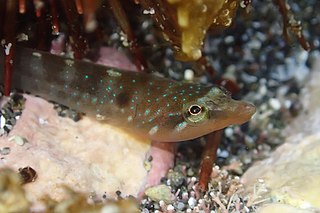
The New Zealand urchin clingfish is a clingfish. It is found around New Zealand wherever sea urchins are present. Its length is between 2 and 3 cm.

Scorpaena cardinalis, the eastern red scorpionfish, grandfather hapuku, cardinal scorpionfish, Cook's scorpionfish, Cook's rockcod, Kermadec scorpionfish, Northern scorpionfish, red scorpion fish, red scorpion-cod or Sandy-bay cod, is a species of marine ray-finned fish belonging to the family Scorpaenidae, the scorpionfishes. It is found in the southwestern Pacific Ocean.
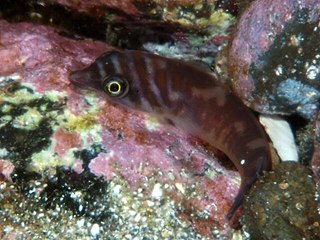
Clingfishes are ray-finned fishes of the family Gobiesocidae, the only family in the suborder Gobiesocoidei of the order Blenniiformes. These fairly small to very small fishes are widespread in tropical and temperate regions, mostly near the coast, but a few species live in deeper seas or fresh water. Most species shelter in shallow reefs or seagrass beds, clinging to rocks, algae and seagrass leaves with their sucking disc, a structure on their chest.
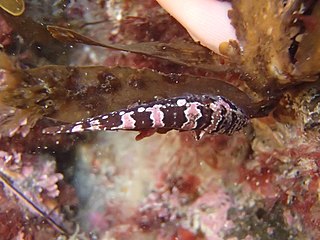
Hector's clingfish is a clingfish of the family Gobiesocidae, the only species in the genus Gastrocyathus. It is found all down the east coast of New Zealand around the low water mark amongst seaweed, on rocky coastlines. Its length is up to 6.4 centimetres (2.5 in) SL. This species was described in 1876 by Albert Günther as Crepidogaster hectoris from a holotype collected on the south shore of the Cook Strait. Günther honoured the Scottish-born scientist James Hector (1834-1907) who was the Director of the Geological Survey of New Zealand and who presented type to the British Museum.

Kuiter's deepsea clingfish is a clingfish of the family Gobiesocidae, found only off southern Australia, at depths of between 90 and 110 metres.
Rudie Hermann Kuiter is an Australian underwater photographer, taxonomist, marine biologist and author of many identification guides to sea fishes. He has described new species of seahorses in the genus Hippocampus.
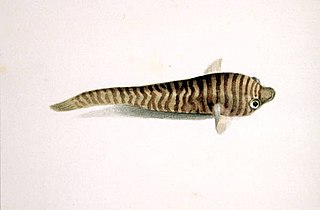
The Tasmanian clingfish is a clingfish of the family Gobiesocidae, found around the western and southern coasts of Australia including Tasmania. Its length is up to 8 cm. This species is found in shallow, coastal, rocky reefs and in the intertidal zone. It is also encountered by scuba divers beneath piers and jetties.
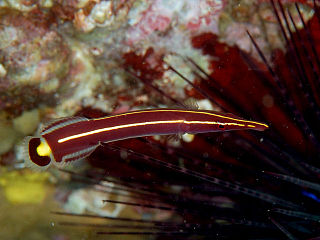
Diademichthys lineatus, commonly known as the long-snout clingfish or urchin clingfish, is a species of marine fish in the family Gobiesocidae.

Chorisochismus dentex, the rocksucker or giant clingfish, is a species of clingfish found along the coast of southern Africa from Namibia to northern Natal, South Africa. It inhabits the intertidal and subtidal zones in shallow reefs and rock pools. This species is the only known member of its genus.

Cochleoceps is a genus of clingfishes endemic to the waters around Australia.

Kopua is a genus of clingfishes found in the Pacific Ocean.

The Posidonia clingfish is a species of clingfish native to the Australia coast. This species grows to a length of 2 centimetres (0.79 in) SL. Pale green to pale blue with fine spots forming dark reticulations on back and sides, larger blue spots often on back, and a pinkish to brown line from snout to gill cover. The posidonia clingfish is endemic to southern Australia where its range extends from Corner Inlet in Victoria west as far as Rottnest Island in Western Australia. It occurs down to a depth of 10 metres (33 ft) where it is found on macroalgae and within seagrass beds, its favoured substrate to adhere to is the leaves of the sea grass Posidonia australis. This species is the only known member of its genus and was described by John C. Briggs in 1993 with a type locality of Fiddler's Bay which is 16 kilometres south of Tamby Bay in South Australia. Briggs gave the species the specific name hutchinsi in honour of the ichthyologist Barry Hutchins of the Western Australia Museum in Perth, Western Australia.

Cochleoceps orientalis, common name eastern cleaner-clingfish, is a species of clingfish that is endemic to the marine waters around southeastern Australia.
Nettorhamphos radula, the duckbilled clingfish, is a species of clingfish from the Indian Ocean off Western Australia. It is currently the sole member of the genus Nettorhamphos.

Diplecogaster bimaculata, the two-spotted clingfish, is a species of fish in the family Gobiesocidae found in Black Sea, Mediterranean Sea and Atlantic Ocean where it is found on rocks and among seagrass or shell beds.
The dwarf shore eel is a species of clingfish from the family Gobiesocidae.It is a small species which attains a maximum total length of 4.5 centimetres (1.8 in). This species is transparent and its internal organs are clearly visible through its skin. It occurs at depths of 0 to 5 metres within beds of seagrass and sometimes in nearby reefs. It is endemic to southern Australia where its range extends from near Sydney in New South Wales to Houtman Abrolhos in Western Australia, including the northern and eastern coasta of Tasmania. This species was described by Victor G. Springer and Thomas H. Fraser in 1976 and the specific name honours the ichthyologist Douglass F. Hoese of the Australian Museum who provided Springer and Fraser with much of the material they used in their description.
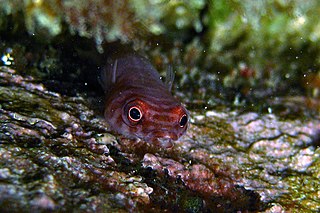
Aspasmogaster costata, the eastern clingfish or pink clingfish is a species of clingfish from the family Gobiesocidae. It is endemic to eastern Australia where it occurs from Byron Bay to the Nadgee Nature Reserve in southern New South Wales and also on Lord Howe Island in the Tasman Sea. This is a secretive species which frequently hides under rocks, shelters in crevices or behind sea urchins at depths down to 20 metres (66 ft). The species was described in 1885 by James Douglas Ogilby with a type locality of Shark Reef near Port Jackson in New South Wales.

Cochleoceps bicolor, the western cleaner clingfish, is a species of clingfish from the family Gobiesocidae which is endemic to southern Australia. This species has a ground colouration which varies from yellowish to reddish marked with regular transverse blue bands along its back and a bluish-grey caudal fin. This species occurs on rocky reefs and jetty or pier piles, where they establish cleaning stations, often over sponges and ascidians, but are known to use a wide variety of reef related sites as stations, perhaps the most important criterion being the prominent visibility of a site to passing parasite laden clients .A station may have from one to multiple Western Cleaner Clingfish, depending on the demand for services and other factors. Some divers have observed shared stations, where several other known temperate marine cleaner host species-notably juvenile moonlighter fish and rockpool shrimp - behave in cooperative fashion, possibly when client demand peaks, tide and season depending. They are thought to feed on parasites which they clean off larger fish. The distribution of this species extends from Lancelin, Western Australia to Port Phillip in Victoria. C. bicolor was described in 1991 by Barry Hutchins from a type locality of Flinders Island.

Lepadichthys frenatus, the bridled clingfish, is a species of clingfish from the family Gobiesocidae. It is found on shallow reefs in the western Pacific Ocean.
Flabellicauda is a genus of clingfishes from the Indian Ocean and Pacific Ocean.














